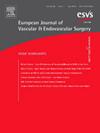单期或两期肱基底动静脉瘘的结局:一项瑞典全国登记研究。
IF 5.7
1区 医学
Q1 PERIPHERAL VASCULAR DISEASE
European Journal of Vascular and Endovascular Surgery
Pub Date : 2025-06-01
DOI:10.1016/j.ejvs.2024.12.027
引用次数: 0
摘要
目的:建立基底静脉动静脉转位瘘(BBAVF)可分为一阶段或两阶段;然而,最佳技术的证据是相互矛盾的。这项全国登记审查的目的是确定两种方法的功能结果是否更有利。方法:这是一项观察性回顾性研究,数据来自瑞典肾脏登记处。纳入2011 - 2019年在18岁以上患者中创建的bbavf,并分为一期(BB1)或两期(BB2)。结果、通畅和并发症从创面开始就被记录下来,所有的开放和血管内重复手术都是如此。结果:BB1s (n = 224)较BB2s (n = 83)多见。在BB2s中,66例(80%)在第二阶段发生转位。不进行转位的最常见原因是闭塞(n = 10)。中位随访时间为2年(四分位数差[IQR] 0.8, 4.2)。总体而言,31%的bbavf从未使用过。静脉狭窄较为常见,157例BB1s(70%), 40例BB2s(48%)。每名患者每年血管内干预的发生率bb1组比bb2组高2倍(0.6 vs. 0.3)。BB1和BB2患者1年的原发性通畅率分别为39%和54% (p = 0.002)。1年和3年的二次通畅在两组间相似(BB1 81%和69%,BB2 82%和78%;p = .14)。糖尿病作为合并症和女性与较差的通畅相关,但体重指数≥30 kg/m2与较差的通畅无关。创作前透析不影响通畅。BB1和BB2从创面到首次穿刺的中位时间分别为73天(IQR 51、157)和141天(IQR 105、225)。结论:两阶段法具有良好的一期通畅性,可通过两次手术加以平衡。两种手术方法的长期通畅性相同。血管内再干预的发生率很高,并且bbbavf在女性和糖尿病患者中作为合并症较少使用。本文章由计算机程序翻译,如有差异,请以英文原文为准。
Editor's Choice – Outcomes of Single or Two Stage Brachiobasilic Arteriovenous Fistula: A Nationwide Swedish Registry Study
Objective
Creation of a brachiobasilic arteriovenous fistula (BBAVF) can be performed as either a one or two stage procedure; however, evidence for the best technique is conflicting. The aim of this national registry review was to determine whether functional outcomes favoured either method.
Methods
This was a retrospective observational study with data from the Swedish Renal Registry. BBAVFs created in patients aged ≥ 18 years between 2011 and 2019 were included and were categorised as one stage (BB1) or two stage (BB2). Outcome, patency, and complications were captured from creation onwards, as were all open and endovascular repeat procedures.
Results
BB1s (n = 224) were more common than BB2s (n = 83). Of the BB2s, 66 (80%) were transposed in the second stage. The most common reason for not performing transposition was occlusion (n = 10). The median follow up was two years (interquartile range [IQR] 0.8, 4.2). Overall, 31% of BBAVFs were never used. Vein stenosis was common, seen in 157 BB1s (70%) and 40 BB2s (48%). The incidence of endovascular interventions per patient year was two times higher in BB1s than BB2s (0.6 vs. 0.3). Primary patency at one year was 39% and 54% in BB1 and BB2, respectively (p = .002). Secondary patency at one and three years was similar between groups (BB1 81% and 69%, and BB2 82% and 78%; p = .14). Diabetes as a comorbidity and female sex were associated with worse patency, but body mass index ≥ 30 kg/m2 was not. Creation pre-dialysis did not affect patency. The median time from creation to first puncture was 73 days (IQR 51, 157) and 141 days (IQR 105, 225) for BB1 and BB2, respectively.
Conclusion
The two stage method had superior primary patency, counterbalanced by two operations. Long term patency was equivalent for the two surgical techniques. The incidence of endovascular re-interventions was high, and BBAVFs were less usable in females and patients with diabetes as a comorbidity.
求助全文
通过发布文献求助,成功后即可免费获取论文全文。
去求助
来源期刊
CiteScore
6.80
自引率
15.80%
发文量
471
审稿时长
66 days
期刊介绍:
The European Journal of Vascular and Endovascular Surgery is aimed primarily at vascular surgeons dealing with patients with arterial, venous and lymphatic diseases. Contributions are included on the diagnosis, investigation and management of these vascular disorders. Papers that consider the technical aspects of vascular surgery are encouraged, and the journal includes invited state-of-the-art articles.
Reflecting the increasing importance of endovascular techniques in the management of vascular diseases and the value of closer collaboration between the vascular surgeon and the vascular radiologist, the journal has now extended its scope to encompass the growing number of contributions from this exciting field. Articles describing endovascular method and their critical evaluation are included, as well as reports on the emerging technology associated with this field.

 求助内容:
求助内容: 应助结果提醒方式:
应助结果提醒方式:


